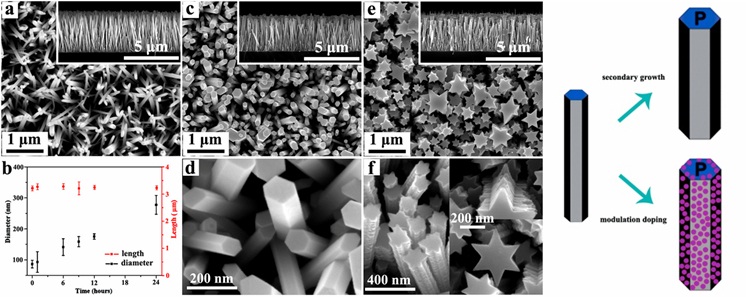Controlled Doping of Nanostructures
The realization of nanoscale devices demands new ways of controlled doping as common doping processes fail to meet the requirements in terms of junction depth and abruptness and 3D doping capability. We develop new methods for doping and related characterization methods.
For 1D semiconductor nanostructures, dopant layers can be formed on the surfaces by a modulation-doping process. Our intention is to develop an extremely low-cost and highly efficient solution method for modulation doping of ZnO nanowires, which can act as an important alternative to the traditional MOCVD route.
 |
| Left: a) SEM image of ZnO nanowires used as the seeds. b) Plots of the average length (red) and diameter (black) of ZnO nanowires as a function of the growth time by the PEG-assisted secondary growth (1 mL PEG). Morphologies of two important stages: 6 h (c, d) and 24 h (e, f). Inset in (a), (c) and (e) is a corresponding cross-sectional SEM image of each sample. Right: Scheme for modulation doping of ZnO nanowires by PEG-assisted secondary growth. |
We found that the polymer polyethylene glycol (PEG) can be used as the capping agent for achieving low-temperature, laterally epitaxial solution growth of ZnO nanowires as reported in [1]. Different from other literature-reported c-axis inhibitors such as anionic citrate and various metal complex ions, PEG represents a more versatile structure-directing agent for ZnO solution growth due to its nonionic, pH-inert and moderate features, which neither significantly changes the chemical reaction environments, nor introduces unexpected dopants in the solution. The above Figures show SEM images of ZnO nanowires formed under the normal growth conditions by seeded solution growth, in which vertically aligned nanowire arrays with about 80 nm in diameter and 3.5 μm in length are observed. Using these ZnO nanowires as the seeds, we investigated the secondary growth of ZnO nanowires assisted by PEG.
[1] R. Kozhummal et al. ACS Nano 6 (8) (2012) 7133-7141, DOI: 10.1021/nn302188q

